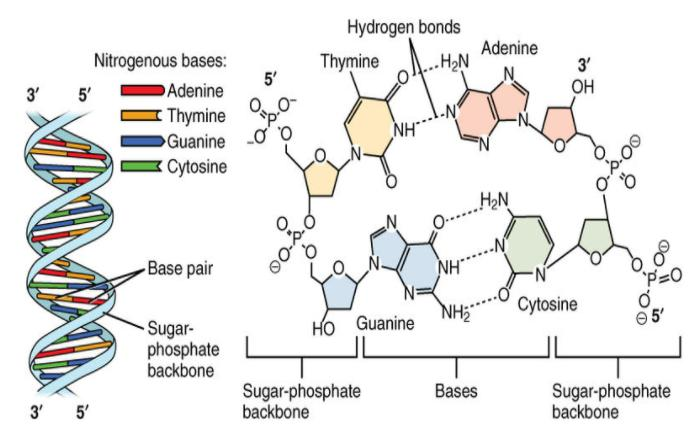
What are the four kinds of nitrogenous bases in DNA?
Answer
493.5k+ views
Hint: DNA is the carrier of heredity. The DNA is present in the nucleus of the eukaryotic cell. It is made up of 4 nitrogenous bases, pentose sugar and phosphate. Nitrogenous bases are nitrogen-containing biological compound. There are 5 different types of nitrogen bases present in DNA and RNA.
Complete answer:
To answer this question, we must know about nitrogenous bases. The nitrogenous bases are the nitrogen-containing biological compounds that form the structural and functional framework of nucleic acid. The nucleobases form a bond between each other and form a stack of nucleic acid that is DNA or RNA. The nucleobases are the fundamental unit of the genetic code. The sequence of bases determines the amino acid.
There are two types of bases present in DNA.
i) Purine- The purine bases have a single amino group. They have a fused ring skeletal structure. Adenine(A) and guanine(G) are the purine bases that have an amino group at the C6 carbon and C2 carbon respectively.
ii) Pyrimidine- These bases have a simple ring structure. The cytosine(C), thymine(T) is the pyrimidine base present in the DNA.
iii) These purine and pyrimidine bases form a bond between each other. A-T and C-G. These are called the complementary bases which have double and triple hydrogen bonds between the anime and the carbonyl group. These complementary bases are responsible for the Double helix of the DNA.
The figure below represents the Structure of DNA, four types of nitrogenous bases, and their bonding with the complementary bases.

So we can say that Adenine, guanine, cytosine and thymine are four bases of DNA.
Note: In the case of RNA, thymine is replaced by uracil. It is structurally similar to thymine but demethylated form. It is the commonly found natural pyrimidine. Uracil forms a double hydrogen bond with adenine.
Complete answer:
To answer this question, we must know about nitrogenous bases. The nitrogenous bases are the nitrogen-containing biological compounds that form the structural and functional framework of nucleic acid. The nucleobases form a bond between each other and form a stack of nucleic acid that is DNA or RNA. The nucleobases are the fundamental unit of the genetic code. The sequence of bases determines the amino acid.
There are two types of bases present in DNA.
i) Purine- The purine bases have a single amino group. They have a fused ring skeletal structure. Adenine(A) and guanine(G) are the purine bases that have an amino group at the C6 carbon and C2 carbon respectively.
ii) Pyrimidine- These bases have a simple ring structure. The cytosine(C), thymine(T) is the pyrimidine base present in the DNA.
iii) These purine and pyrimidine bases form a bond between each other. A-T and C-G. These are called the complementary bases which have double and triple hydrogen bonds between the anime and the carbonyl group. These complementary bases are responsible for the Double helix of the DNA.
The figure below represents the Structure of DNA, four types of nitrogenous bases, and their bonding with the complementary bases.

So we can say that Adenine, guanine, cytosine and thymine are four bases of DNA.
Note: In the case of RNA, thymine is replaced by uracil. It is structurally similar to thymine but demethylated form. It is the commonly found natural pyrimidine. Uracil forms a double hydrogen bond with adenine.
Recently Updated Pages
Master Class 12 Business Studies: Engaging Questions & Answers for Success

Master Class 12 Economics: Engaging Questions & Answers for Success

Master Class 12 English: Engaging Questions & Answers for Success

Master Class 12 Maths: Engaging Questions & Answers for Success

Master Class 12 Social Science: Engaging Questions & Answers for Success

Master Class 12 Chemistry: Engaging Questions & Answers for Success

Trending doubts
Who was the first woman to receive Bharat Ratna?

Write a letter to the principal requesting him to grant class 10 english CBSE

Why is there a time difference of about 5 hours between class 10 social science CBSE

What is the median of the first 10 natural numbers class 10 maths CBSE

The Equation xxx + 2 is Satisfied when x is Equal to Class 10 Maths

Discuss the main reasons for poverty in India




